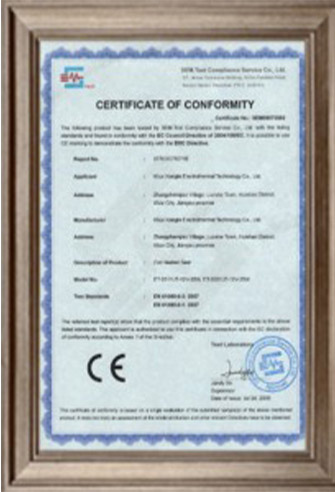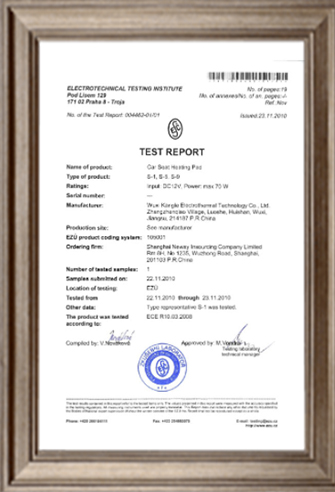Condenser.
Condenser, a part of the refrigeration system, belongs to a heat exchanger, which can convert gas or vapor into liquid, and transfer the heat in the tube to the air near the tube in a very fast way. The working process of the condenser is a heat release process, so the temperature of the condenser is high.
Many condensers are used in power plants to condense the steam from turbines. Condensers are used in refrigeration plants to condense refrigeration vapors such as ammonia and freon. Condensers are used in the petrochemical industry to condense hydrocarbons and other chemical vapors. In the distillation process, the device that changes the vapor into a liquid state is also called the condenser. All condensers operate by taking away the heat from gases or vapors.
The mechanical part of the refrigeration system, which belongs to a heat exchanger, can convert gas or vapor into liquid, and transfer the heat in the pipe to the air near the pipe in a very fast way. The working process of the condenser is a heat release process, so the temperature of the condenser is high.
Many condensers are used in power plants to condense the steam from turbines. Condensers are used in refrigeration plants to condense refrigeration vapors such as ammonia and freon. Condensers are used in the petrochemical industry to condense hydrocarbons and other chemical vapors. In the distillation process, the device that changes the vapor into a liquid state is also called the condenser. All condensers operate by taking away the heat of a gas or vapor. [1]
principle
The gas passes through a long tube (usually coiled into a solenoid), allowing heat to be lost to the surrounding air. Metals such as copper, which conduct heat, are often used to transport steam. In order to improve the efficiency of the condenser, heat sinks with excellent heat conduction performance are often attached to the pipes to increase the heat dissipation area to accelerate heat dissipation, and the air convection is accelerated through the fan to take away the heat.
In the circulating system of the refrigerator, the compressor inhales low-temperature and low-pressure refrigerant steam from the evaporator, which is adiabatic compressed into high-temperature and high-pressure superheated steam by the compressor, and then pressed into the condenser for constant pressure cooling, and releases heat to the cooling medium, and then cooled into the supercooled liquid refrigerant. The liquid refrigerant becomes a low-pressure liquid refrigerant through the expansion valve adiabatic throttling, evaporates and absorbs the heat in the air conditioning circulating water (air) in the evaporator, thus cooling the air conditioning circulating water to achieve the purpose of refrigeration, and the refrigerant flowing out of the low pressure is sucked into the compressor, so the cycle works.
Single-stage steam compression refrigeration system is composed of four basic components of refrigeration compressor, condenser, throttle valve and evaporator, which are successively connected by pipes to form a closed system, and the refrigerant constantly circulates in the system, changes state, and exchanges heat with the outside world.
Make up
In the refrigeration system, the evaporator, the condenser, the compressor and the throttle valve are the four essential parts of the refrigeration system, in which the evaporator is the equipment that transmits the cold amount. The refrigerant absorbs the heat of the object being cooled to achieve cooling. The compressor is the heart, which plays the role of inhaling, compressing and transporting refrigerant steam. The condenser is a device that releases heat, transferring the heat absorbed in the evaporator along with the heat converted by the compressor work to the cooling medium. The throttle valve plays the role of throttling and reducing the pressure of the refrigerant, while controlling and regulating the amount of refrigerant liquid flowing into the evaporator, and the system is divided into two parts: the high pressure side and the low pressure side. In the actual refrigeration system, in addition to the above four large parts, there are often some auxiliary equipment, such as solenoid valves, dispensers, dryers, collectors, fusible plugs, pressure controllers and other components, which are set to improve the economy, reliability and safety of operation.
According to the condensing form, the air conditioner can be divided into water-cooled and air-cooled, and according to the purpose of use, it can be divided into single-cooled and refrigerated and warmed, no matter which type of composition, it is composed of the following main components.
The necessity of condenser is based on the second law of thermodynamics - according to the second law of thermodynamics, the spontaneous flow direction of heat energy inside a closed system is one-way, that is, it can only flow from high heat to low heat, and the microscopic particles that carry heat energy in the microscopic world can only change from order to disorder. Therefore, when a heat engine has energy input to do work, the downstream must also have energy release, so that there will be a thermal energy gap between the upstream and downstream, the flow of thermal energy will become possible, and the cycle will continue.
Therefore, if you want the carrier to do work again, you must first release the heat energy that is not completely released, and you need to use the condenser at this time. If the surrounding heat energy is higher than the temperature in the condenser, in order to cool the condenser, work must be done (generally using a compressor). The condensed fluid returns to a state of high order and low thermal energy, and work can be done again.
The selection of the condenser includes the choice of form and model, and determines the flow and resistance of the cooling water or air flowing through the condenser. The choice of condenser type should consider the local water source, water temperature, climate conditions, as well as the size of the total cooling capacity of the refrigeration system and the layout requirements of the refrigeration room. Under the premise of determining the condenser type, the heat transfer area of the condenser is calculated according to the condensing load and the heat load per unit area of the condenser, so as to select the specific condenser model.
System composition
After absorbing the heat of the cooled object in the evaporator, the liquid refrigerant vaporizes into high temperature and low pressure steam, is inhaled by the compressor, compressed into high pressure and high temperature steam and then enters the condenser, releases heat to the cooling medium (water or air) in the condenser, condenses into high pressure liquid, is throttled by the throttle valve for low pressure and low temperature refrigerant, and enters the evaporator again to absorb heat and vaporize. To achieve the purpose of circulation refrigeration. In this way, the refrigerant in the system through evaporation, compression, condensation, throttling four basic processes to complete a refrigeration cycle.
The main components are compressor, condenser, evaporator, expansion valve (or capillary, supercooling control valve), four-way valve, multiple valve, check valve, solenoid valve, pressure switch, fuse, output pressure regulating valve, pressure controller, liquid storage tank, heat exchanger, collector, filter, dryer, automatic opening and closing device, stop valve, liquid injection plug and other components.
electric
The main components are motors (compressors, fans, etc.), operating switches, electromagnetic contactors, interlocking relays, overcurrent relays, thermal overcurrent relays, temperature regulators, humidity regulators, temperature switches (for defrosting, preventing freezing, etc.). Compressor crankcase heater, water relay, computer board and other components.
Controls
Consists of a number of control devices, which are:
Refrigerant controller: expansion valve, capillary, etc.
Refrigerant circuit controller: four-way valve, check valve, double valve, solenoid valve.
Refrigerant pressure controller: pressure opener, output pressure regulator, pressure controller.
Motor protector: overcurrent relay, thermal overcurrent relay, temperature relay.
Temperature regulator: temperature level regulator, temperature proportional regulator.
Humidity regulator: humidity level regulator.
Defrosting controller: defrosting temperature switch, defrosting time relay, various temperature switches.
Cooling water control: water relay, water regulating valve, water pump, etc.
Alarm control: over-temperature alarm, ultra-wet alarm, under-voltage alarm, fire alarm, smoke alarm, etc.
Other controls: indoor fan speed controller, outdoor fan speed controller, etc.
If you want to know more, keep reading the other articles on this site!
Please call us if you need such products.
Zhuo Meng Shanghai Auto Co., Ltd. is committed to selling MG&MAUXS auto parts welcome to buy.













